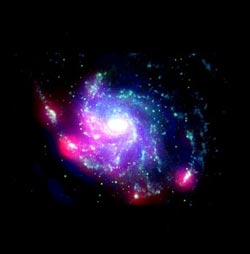Akari’s observations of galaxy M101

This is a composite image of the spiral galaxy M101. The image shows the distribution of cold (blue) and warm (red) dust overlaid on the visible (green, showing distribution of stars) and far-ultraviolet (cyan, indicating the location of young stars) images of M101. Credits: Composite: JAXA, visible (green): the National Geographic Society, far-ultraviolet (cyan): GALEX/NASA
Toyoaki Suzuki at the University of Tokyo conducted observations of M101 with AKARI at four infrared wavelengths (65, 90, 140, and 160 micrometres) using the Far-Infrared Surveyor (FIS) instrument.
Many young high-temperature stars populate the spiral arms, revealing the areas of star formation and warming the interstellar dust. This causes the galaxy to shine at shorter infrared wavelengths. In contrast, the longer wavelengths show where the ‘cold’ dust is located. Normal stars, typically like our own Sun, warm this dust.
FIS data was compared to an image of M101 in the visible and far-ultraviolet. It shows that warm dust is distributed along the spiral arms, with many hot spots located along the outer edge of the galaxy. These spots correspond to giant star-forming regions. This is unusual because star formation is generally more active in the central parts of spiral galaxies.
The evidence points to M101 having experienced a close encounter with a companion galaxy in the past, dragging out gas from the hapless companion. The gas is now falling onto the outer edge of M101 at approximately 150 km/s, triggering the active star formation.
Media Contact
More Information:
http://www.esa.int/esaSC/SEMYRSMPQ5F_index_0.htmlAll latest news from the category: Physics and Astronomy
This area deals with the fundamental laws and building blocks of nature and how they interact, the properties and the behavior of matter, and research into space and time and their structures.
innovations-report provides in-depth reports and articles on subjects such as astrophysics, laser technologies, nuclear, quantum, particle and solid-state physics, nanotechnologies, planetary research and findings (Mars, Venus) and developments related to the Hubble Telescope.
Newest articles

A universal framework for spatial biology
SpatialData is a freely accessible tool to unify and integrate data from different omics technologies accounting for spatial information, which can provide holistic insights into health and disease. Biological processes…

How complex biological processes arise
A $20 million grant from the U.S. National Science Foundation (NSF) will support the establishment and operation of the National Synthesis Center for Emergence in the Molecular and Cellular Sciences (NCEMS) at…

Airborne single-photon lidar system achieves high-resolution 3D imaging
Compact, low-power system opens doors for photon-efficient drone and satellite-based environmental monitoring and mapping. Researchers have developed a compact and lightweight single-photon airborne lidar system that can acquire high-resolution 3D…





















